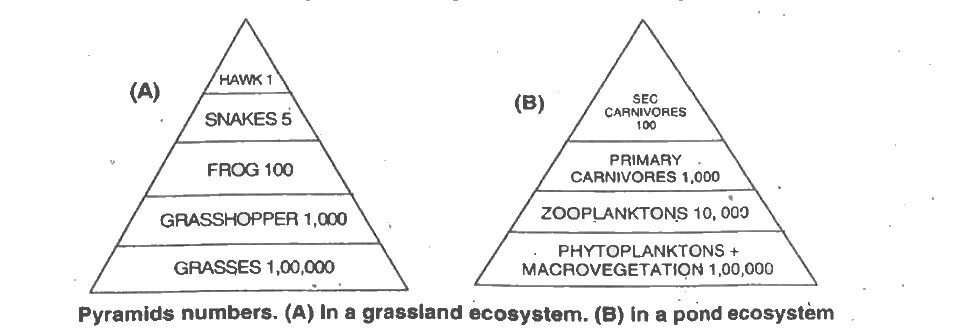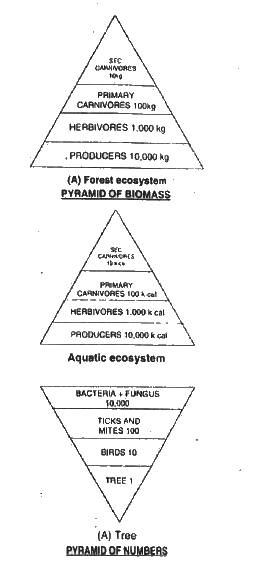Define ecological pyramids and describe with examples the different types.Solution in Kannada
It is the graphic representation of trophic structure and function of a food chain. It is so called due to its superficial resemblance to Egyptian pyramid. The Pyramid concept in ecology was proposed by Charles Elton and hence they are also called Eltonium pyramid.
Usually broad below and tapering fowards the apex, producers occupy the broad base while animals of Consumers occupy successive steps tapering into the apex of the pyramid. There are 4 types of ecological pyramids namely.
1. Pyramid of number : It is graphic representation of numerical relationship between successive trophic levels in a food chain. Usually upright pyramid and it illustrates decreasing number of individuals at successive trophic level from producers to consumers. Number of individual ismaximum in producers compared to consumers, e.g.: Pond food chain. Pyramids numbers. (A) In a grassland ecosystem. (B) in a pond ecosystem
Pyramid of Biomass : It is graphical representation of biomas at successive trophic level in a food chain. Biomas is the total dry weight of an organismkor all organisms of a trophic level. It is expressed as pounds or kilograms. Usually upright pyramid and illustrates decreasing biomas at successive trophic levels from producers at the base to the consumers. Biomas of producers is maximum. It is less in Consumers. Ex.: Pond food chain.
3. Pyramid of Energy : It is graphic representation of available energy at successive trophic levels in a food chain. Energy level is expressed as kilocalorie. It is the typical upright pyramid. It illustrate decreasing energy level at successive trophic levels from producers at the base to the consumers. Energy level is maximum in producers, less in consumers. Ex.: Pond food chain.
4. Pyramid of a parasitic food chain (Inverted Pyramid) : In the case of parasitic food chain the pyramid of number becomes inverted. Ex. A single large tree (Tl) feeds and shelter severalfruit eating birds (T2). They further feeds and shelter many ecto parasites (ticks & fleas) T3. These inturn feed and shelter numerous hyperparasite (Bacteria and fungi) T4. Thus it indicates increasing number of individuals at successive trophic level from base to apex resulting an inverted pyramid with tapering base below and broad apex above.


Topper's Solved these Questions
- SUPER MODEL QUESTION PAPER 1BOOK - SUBHASH PUBLICATIONCHAPTER - SUPER MODEL QUESTION PAPER 1EXERCISE - ANSWER THE FOLLOWING QUESTIONS IN ONE WORD OR ONE SENTENCE EACH
10 Videos
- SUPER MODEL QUESTION PAPER 1BOOK - SUBHASH PUBLICATIONCHAPTER - SUPER MODEL QUESTION PAPER 1EXERCISE - PART B
8 Videos
- SUPER MODEL QUESTION PAPER 1BOOK - SUBHASH PUBLICATIONCHAPTER - SUPER MODEL QUESTION PAPER 1EXERCISE - PART-D (SECTION-I)
6 Videos
- SUPER MODEL QUESTION PAPER (FOR PRACTICE) 3BOOK - SUBHASH PUBLICATIONCHAPTER - SUPER MODEL QUESTION PAPER (FOR PRACTICE) 3EXERCISE - PART-D (SECTION-II)
5 Videos
- SUPER MODEL QUESTION PAPER 2BOOK - SUBHASH PUBLICATIONCHAPTER - SUPER MODEL QUESTION PAPER 2EXERCISE - PART D
11 Videos
Similar Questions
Describe Eutrophication.
View SolutionDifferentiate between oviparous and viviparous animals with a suitable example for each.
View SolutionDraw the T.S. of a mature anther and explain briefly.
View SolutionDraw the T.S. of mature anther and explain briefly.
View SolutionWrite a neat labelled diagram of T.S of Anther.
View SolutionDefine ecological pyramids and describe with examples, pyramids of number and biomass.
View Solutionपारिस्थितिक पिरामिड क्या है? विभिन्न प्रकार के पिरामिडों का वर्णन कीजिए।
View SolutionDefine ecological pyramids and describe with examples, pyramids of number and biomass.
View SolutionDefine ecological pyramid. Name different types of ecological pyramids.
View SolutionDefine ecological pyramid? Describe pyramid of energy flow with a example.
View SolutionDefine ecological phramids .Name the different types of ecological pyramids.
View SolutionDefine ecological pyramids and descibe with example the different types:
View SolutionDefine ecological pyramids and describe with examples pyramids of number and biomass.
View SolutionDefine ecological pyramids and describe numerical pyramids and tuna pyramids as examples. (TQ)
View SolutionDefine ecological pyramids and describe with examples, pyramids of number and biomass.
View Solution
